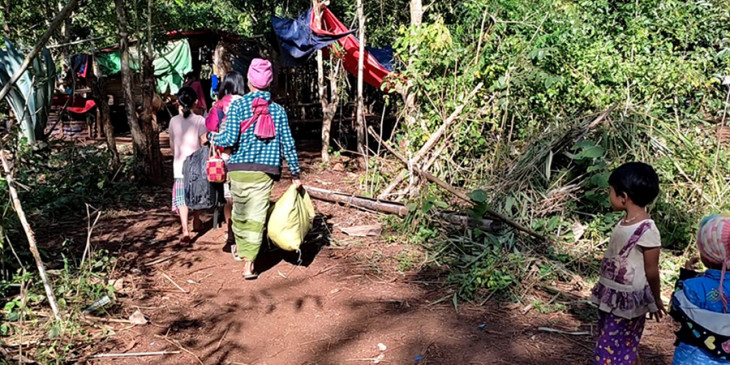A human rights group says that food and other essential supplies for IDPs in Demoso could run out by the new year. Currently, more than a sixth of all of Burma’s internal refugees are taking shelter within Kayah’s jungle and IDP camps scattered around the state.
When conflict forced villagers from their homes on May 21, the displaced say they never considered that soon they would be facing their seventh month in the jungle.
“I, myself, never thought this displacement period would last long. People also thought that it would last a week or two,” said Karenni Human Rights Group spokesperson, Ko Banyar.
“Elders especially wanted to return home, but middle-aged and young people don’t because they think battles could return at any time.”
While conservative estimates place the number of Kayah, also known as Karenni, refugees at around 88,000, Ko Banyar says the number is actually closer to 110,000 of the nearly 638,000 displaced overall.
While a month-long ceasefire negotiated between religious and ethnic groups initially gave the displaced villagers hope, most have been stranded for anywhere from three to seven months on the fringes of Demoso, Hpruso, Moe Bye, and Loikaw—where military troops are currently deployed.
Almost 45% of Demoso’s IDPs reside in around 35 makeshift camps established within the township, where blue plastic tarpaulin provides scarce protection from the elements to the young and the elderly. Those more fortunate have found shelter in monasteries, churches, or with friends and family in nearby villages.
Further fueling the desperation is the difficulty in accessing these remote areas, to where Ko Banyar says it is even difficult to deliver food. Electricity supplies to the western and eastern parts of Demoso have also been cut, with infrequent resumptions, since September after fighting between the Burma Army and resistance fighters intensified.
Ironically, the rich agricultural land many IDPs have fled from—the borders of Demoso, Loikaw, and Moebyal—is often hailed as the “rice bowl of the state”. Whilst some villagers have been able to return to tend to their fields, Ko Banyar fears for next year’s output; the extent of the displacement has never been this bad.
“My concern is for 2022,” he said. “If the situation continues like this, there will be a huge gap for planting paddy in the monsoon season and this will harm the state’s rice production by 10 to 20%. Only 50% of the rice can be produced this year.”
According to Ko Banyar, around 80% of aid assigned to deal with Kayah’s looming humanitarian crisis comes from overseas, with remaining funds flowing from domestic CSOs, nonprofits, and the National Unity Government. Funds from larger INGOs dried up in May, and Ko Banyar worries about the increasing reliance on the diaspora and internal donors as larger organizations continue to fail to provide.
Ko Banyar says that he has been told by INGO representatives that it would be easier for them to distribute aid if a main camp was established in Demoso—an almost impossible task as long as battles continue to rage.
“I already informed them that a quarter of our state has been displaced into the jungle—and I’m afraid that people cannot afford to donate this long,” he said.
“Battles are taking place everywhere in our state. We would be taking a huge risk in building a main camp in Demoso, as we fear that this would highlight the location of IDPs to the military. And another fact [hampering aid efforts] is that the military doesn’t allow them to do their operation in our region.”
The World Food Program reports that they have been able to provide food assistance to over 2.4 million people in Myanmar this year, and accessing displaced people affected by armed conflict is one of the organization’s top priorities.
“These displaced people are facing imminent food shortages and have other critical needs particularly as cold temperatures are setting in,” said WFP Myanmar Country Director Stephen Anderson. “WFP has reports that many displaced people are only able to survive thanks to minimal and intermittent support received mostly from local civil society organizations.”
WFP is working to gain access to IDPs across the country, and recently delivered aid to refugees in Kyauktu, Magway, where thousands of villagers had been displaced in November after fighting between Yaw PDF and the Tatmadaw.
Anderson says the WFP is working with other UN agencies to continue advocating for access to Demoso.



